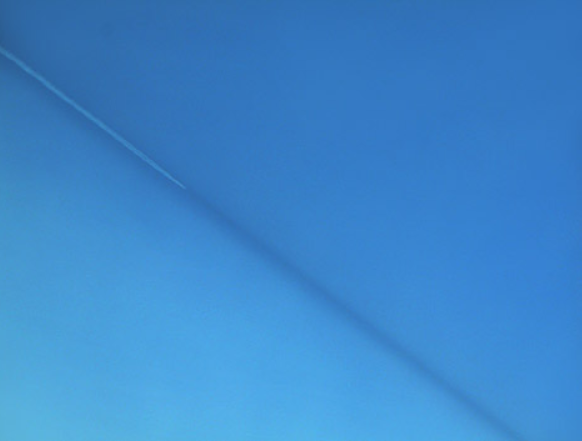Contrail Shadows
Contrail Shadows: A Phenomenon in the Sky
Contrail shadows are a fascinating atmospheric optics phenomenon that occurs when an aircraft's contrail, or condensation trail, casts a shadow on the clouds below. These shadows can stretch across the sky, creating mesmerizing visual displays for observers on the ground. In this article, we will delve into the intricacies of contrail shadows, exploring their formation, characteristics, and the conditions necessary for their occurrence.
Understanding Contrails and their Shadows
Contrails are the long, thin clouds that form behind aircraft when hot exhaust gases mix with the cold air in the upper atmosphere. These clouds consist of tiny ice crystals and can persist for varying lengths of time, depending on atmospheric conditions. When the sun is low in the sky, contrails can cast shadows on clouds below, resulting in the phenomenon known as contrail shadows.
The Formation of Contrail Shadows
Contrail shadows are formed when the contrail crosses in front of the sun, blocking its light and casting a shadow on the cloud layer beneath. The shadow appears as a dark streak or band on the clouds, contrasting against the surrounding bright sky. The shape and length of the shadow depend on factors such as the altitude of the aircraft, the angle of the sun, and the thickness and type of clouds present.
Characteristics of Contrail Shadows
Contrail shadows can exhibit several distinct characteristics that make them captivating to observe. Here are some notable features:
-
Length and Extent: Contrail shadows can extend for long distances across the sky, sometimes reaching all the way to the antisolar point. This creates a striking visual effect as the shadow stretches across the cloud layer.
-
Needle-Like Shape: The shadow cast by a contrail often appears needle-like, with a thin and elongated form. This shape is a result of the contrail's narrow width and its position in relation to the sun.
-
Contrast and Sharpness: Contrail shadows are typically well-defined and sharply delineated, standing out against the clouds. The stark contrast between the shadow and the surrounding sky enhances their visibility.
Conditions for Contrail Shadows
Contrail shadows are not a common occurrence and require specific conditions to manifest. Here are the key factors necessary for the formation of contrail shadows:
-
Sun Position: Contrail shadows can only be observed when the sun is relatively low in the sky, typically below an altitude of 30 degrees. This angle allows the contrail to intersect the sun's path and cast a visible shadow on the clouds.
-
Cloud Layer: The presence of a smooth layer of clouds beneath the contrail is essential for the formation of a distinct shadow. Cirrostratus clouds, with their thin and uniform composition, are particularly conducive to the development of pronounced contrail shadows.
-
Contrail Persistence: For a contrail shadow to be visible, the contrail itself must persist for a significant amount of time. Factors such as atmospheric humidity and temperature determine how long a contrail remains intact, influencing the potential for shadow formation.
Observing Contrail Shadows
To witness the mesmerizing display of contrail shadows, it is important to position oneself in an optimal location and be aware of the right conditions. Here are some tips for observing contrail shadows:
-
Choose a vantage point with an unobstructed view of the sky, away from tall buildings or trees that may obstruct your line of sight.
-
Look for days when the sky is relatively clear, with a smooth layer of cirrostratus clouds present below the contrails.
-
Check the time of day and the sun's position to ensure it is low enough in the sky for shadow formation.
-
Be patient and observant, as contrail shadows may take time to develop and become visible.
Conclusion
Contrail shadows offer a captivating glimpse into the interplay between aircraft, clouds, and the sun in the Earth's atmosphere. These elongated shadows, stretching across the sky, create stunning visual effects that leave observers in awe. By understanding the formation and characteristics of contrail shadows, as well as the conditions necessary for their occurrence, we can better appreciate the beauty and complexity of atmospheric optics. So, keep your eyes to the sky and be ready to witness the enchanting dance of contrail shadows on a clear day.

An aircraft chases its own contrail shadow. The contrail crossed the sun and its needle-like shadow extrended well across the sky towards the antisolar point. The shadow was cast onto a smooth layer of cirrostratus cloud beneath the aircraft. November 2nd 2002, sun 20° high. Photo ©2002 Les Cowley
Note: this article has been automatically converted from the old site and may not appear as intended. You can find the original article here.
Reference Atmospheric Optics
If you use any of the definitions, information, or data presented on Atmospheric Optics, please copy the link or reference below to properly credit us as the reference source. Thank you!
-
<a href="https://atoptics.co.uk/blog/contrail-shadows-2/">Contrail Shadows</a>
-
"Contrail Shadows". Atmospheric Optics. Accessed on April 27, 2024. https://atoptics.co.uk/blog/contrail-shadows-2/.
-
"Contrail Shadows". Atmospheric Optics, https://atoptics.co.uk/blog/contrail-shadows-2/. Accessed 27 April, 2024
-
Contrail Shadows. Atmospheric Optics. Retrieved from https://atoptics.co.uk/blog/contrail-shadows-2/.